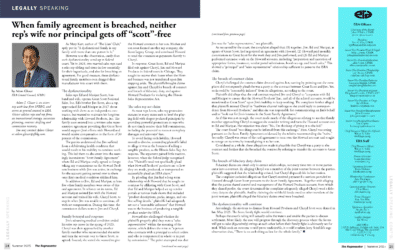Prominent among judicial doctrines ripe for reversal — right up there with contributory negligence and baseball’s antitrust exemption — is the rule immunizing the government from negligence claims by military personnel for injuries suffered on the job.
The Supreme Court long ago carved out a military exception to the Federal Tort Claims Act, the law that subjects the government to suit when the negligence of federal workers causes injuries. In Feres v. U.S., 349 U.S. 135 (1950), injured service members, unlike most other Americans, were deemed unable to sue under the FTCA when their “injuries arise out of or are in the course of activity incident to service.”
Not surprisingly, rendering injured servicemen ineligible to receive compensation from the government whose actors tortuously injure them has received healthy criticism.
Dissenting on behalf of Justices William H. Brennan, Thurgood Marshall and John Paul Stevens, Justice Antonin G. Scalia decried that Feres “was wrongly decided and heartily deserves the widespread, almost universal criticism it has received.” U.S. v. Johnson, 481 U.S. 681, 700 (1987).
The 7th U.S. Circuit Court of Appeals has noted the Feres doctrine “is certainly not without controversy … and has also been widely criticized.” Purcell v. U.S., 656 F.3d 463, 465 (7th Cir. 2011). Federal courts frequently express regret for having to follow Feres.
An extreme example of doctrine’s unfairness is found in the serious misfortune suffered by Air Force Capt. Heather Ortiz, which may just lead to the doctrine’s demise.
A federal complaint filed in Colorado alleged that Ortiz experienced complications after the medical staff at Evans Army Community Hospital in Colorado Springs, Colo., administered a drug in preparation for her cesarean section. To counteract her known allergy to the drug, a doctor prescribed Benadryl, which caused her blood pressure to drop and led to hypotension.
The hospital staff did not immediately notice the fetal monitoring readings displaying the baby’s distress. As a result, Ortiz’s daughter, Bella, was deprived of oxygen in utero and suffered severe injuries, including brain trauma and cerebral palsy, requiring 24-hour medical attention and supervision.
Although the choice of drugs administered and the actions of the hospital staff appear to have deviated from the standard of care and amount to negligence, the Feres doctrine clearly prevented Ortiz from suing the government. Her civilian husband therefore attempted to bring the suit on behalf of their grievously injured daughter.
The U.S. District Court promptly dismissed, ruling that Feres barred the infant’s negligence claims just as the mother’s. The appellate court reluctantly affirmed in Ortiz v. U.S., 786 F.3d 817 (10th Cir. 2015), noting the Feresdoctrine bars suits by third parties that derive, even indirectly, from injuries to servicemen incident to their military duties.
The bar takes the form of the “genesis test,” which holds that if a third-party civilian’s injury has its origin or “genesis” in a serviceman’s service-related injury, then Feres precludes suit same as if the serviceman attempted to sue. The 10th Circuit viewed the genesis test as “the appropriate mechanism to apply to third-party Feresclaims involving derivative third-party injuries, including those occurring in utero.”
“We wish, frankly, that were not the case,” the court remarked, making clear its agreement with the doctrine’s critics, even while affirming the dismissal. “To be sure, the facts here exemplify the overbreadth (and unfairness) of the doctrine, but Feres is not ours to overrule.”
What makes the court’s treatment of the birth-injury at issue in the Ortiz case so compelling is it highlights how the genesis test applies unequally to parents in the service based on their sex.
Bella’s injury unquestionably originated from her mother’s service-related injury, and the 10th Circuit therefore found the charged negligence was not actionable under the Feres doctrine. However, had the same medical negligence unfolded while the baby’s father was in active military service, Feres would not stand in the way.
When the military member is the father, the “genesis” of the injury would involve malpractice committed against a serviceman’s spouse, not a service-related injury, which falls well beyond the reach of Feres.
This discriminatory effect is featured in Ortiz’s petition for writ of certiorari filed with the U.S. Supreme Court on Oct. 13. Urging that Feres should not bar birth-injury claims of military children, the petition stands a better than average chance of gaining a hearing because other appellate courts take a different view of the genesis test, creating a significant circuit split.
Refusing to apply the genesis test to preclude suit for neonatal injuries, the 4th, 8th and 11th Circuits have all held that a child has a distinctive claim from the mother’s potential claim. Unlike the 10th Circuit, these courts ruled that Feres does not stand in the way of a child’s suit for birth injuries sustained from medical malpractice committed against the military mother.
For example, the 8th Circuit concluded that an “infant suing a physician for birth injuries is a patient in his own right, the cause of action for injuries he sustained belongs to him, is separate from any cause of action the mother may have for negligent care and is not derivative of the mother’s claim for injuries.” Mossow v. U.S., 987 F.2d 1365 (8th Cir. 1993).
The 10th Circuit’s expressed view that it must apply the overly broad and unfair Feres doctrine to bar Bella Ortiz’s birth-injury claim, while splitting with other circuits that refuse to do so in similar circumstances, should be enough to trigger high court review of its application here, even if not to the entire doctrine’s continued viability.
To view this article as it appears in the Chicago Daily Law Bulletin, click here.



